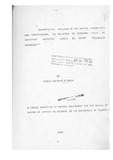| dc.description.abstract | This study was carried out to investigate dry matter production and partitioning in beans (phaseolus vulgaris . L) and to relate to various plant parameters to economic yield . Two cultivars , “small Rosecoco (NB1122) and “Mwezi moja” (NB 518) were studied and compared at different levels of applied water throughout the growth period
Two experiMents were conducted in a glasshouse and one under field conditions. The glasshouse experiments were conducted from December 21, 1982 to march 17, 1980 and from July 20, 1983 to October 17, 1983. The field experiment was conducted from July 21, 1983 to Octiber 18, 1983. All the experiments were conducted at the field station, Faculty of Agriculture, Kabete, University of Nairobi
The experimental design in the glasshouse was a split-Split plot design with 3 replicates. The watering regimes formed the main-plot, the cultivars the sub-plot and the sampling interval the sub-sub plot. Planting was done in buckets of 20 litres, with 8 plants per bucket in the glasshouse. Trhee watering treatment were applied: watering at field capacity (FC), ½ of FC and 1/4 of FC. Watering was done every 2 days. Sampling commenced after emergence and continued at an interval of 10 days maturity.
The measurements made were mainly of leaf area and dry matter weights of the various plants parts viz, root, stem, leaf, pod wall and seed. Leaf area ratio, root to shoot ratio and harvest index were computed. The number of the pods per plant and seeds per pod were also determined.
The results showed that dry matter production decreased as the water applied decreased. Although there was a decrease in root dry matter, the root to shoot ratio increased as the water applied decreased. Dry matter in the stem and the leaf also decreased. Both leaf area index and leaf area ratio were also adversely affected by decreasing applied water.
Durin the growth period , all the parameters (including the root) exhibited a general pattern of an initial increase in dry matter and then a decrease. Redistribution of assimilates from the various plant parameters to the developing reproductive organs was observed at all levels of applied water. In the loss of dry matter, the root was affected before the stem. It was also apparent from this study that the cultivars behave in a similar manner in DH production and partitioning throughout the growth period at the various levels of applied water.
The results obtained in the glasshouse were comparable with those of the field study in which only the final harvest data were taken. The major differences being that weight of the plant parts from the field study were generally higher than those in the glasshouse. | en |

